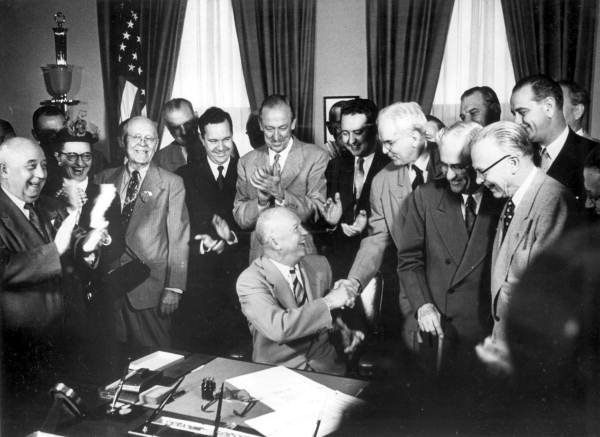Petersen Archive | Dwight D Eisenhower — Petersen Automotive Museum

The postwar era was a time described by unprecedented prosperity. Pursuing the Next Globe War, returning GI’s came property to a booming financial system, housing enhancement assignments, and aid systems like the GI Bill that expanded and cemented America’s middle course. By 1950 most factories, which include auto brands, had produced the changeover from wartime creation to a client-dependent economic climate, so considerably so that, in that 12 months alone, 8 million autos have been developed, by 1958 a lot more than 67 million automobiles would be manufactured and registered in the United States. Even so, at the start out of the ten years, most of America’s out of date roads had been in no situation to aid a massive inflow of targeted visitors. Tension for building of transcontinental superhighways experienced been escalating considering that the late 1930s, on the other hand, conflict between city passions and rural pursuits vying for priority and a lack of funding still left early tasks these kinds of as the 1944 Federal-Support Highway Act useless in the drinking water. By the 1950’s, in get to manage an influx of new vehicle house owners president Dwight D. Eisenhower publicly supported an interstate highway enhancement plan and on June 29, 1956, he signed the Highway Income Act also acknowledged as the Nationwide Interstate and Defense Highways Act into regulation. The act marked the premier American public works system of that time authorizing the design of 41,000 miles of interstate highways fitted with overpasses and confined-accessibility belt lines. Eisenhower experienced been heavily affected by his experiences in 1919 as a participant in the U.S. Army's initial Transcontinental Motor Convoy across the United States and his observations of the German audubon freeway community throughout Environment War II. Owning recognized the value of mobility and effectiveness, Eisenhower proposed an American interstate freeway system in his State of the Union tackle in 1954, which he framed as a national protection program. In an exertion to stimulate a cooperative alliance between state and federal officials, retired Common Lucius D. Clay, an engineer and a long-time advisor to the president, proposed a plan in which the federal governing administration would pay out 90 per cent of the cost of expressway design the funding for which would arrive from an improved gasoline tax (now 3 cents a gallon). Interstate funds had been to then be dispersed in the ratio of each individual point out's believed cost of completing the technique. The 1st job underneath the Act was the Mark Twain Expressway (Interstate 70) in St. Charles County, Missouri.
The highways have been intended to remove targeted visitors congestion substitute “undesirable slum regions with pristine ribbons of concrete” as 1 highway advocate place it make coast-to-coast transportation extra effective and make it easy to evacuate huge towns in case of an atomic attack. While transformative, the Highway Earnings Act also mirrored an enduring legacy of Jim Crow period discriminatory procedures and systemic racism. Lower-value home loans by way of the G.I. Invoice (which was not provided to black GI’s), enabled white family members to abandon inner cities in favor of suburban housing as perfectly as stop ethnic minorities from executing the exact. Federal planners of the interstate freeway process routed some highways immediately, and usually purposefully, via predominantly black and brown neighborhoods to predominantly white suburban neighborhoods. Despite the fact that the Highway Revenue Act was initially achieved with prevalent public help, as extra folks turned displaced and ailments in towns deteriorated, activists started to overtly oppose the process, some heading as considerably as forcing building stoppages throughout the late 1950s and early 60s. Through the 1960s, civil rights activists and environmentalists across the country in New York Metropolis, Baltimore, Washington, D.C. New Orleans and other metropolitan areas managed to avert roadbuilders from dividing and subjugating their neighborhoods, ultimately nevertheless, most of the 41,000 miles of interstate were being concluded.
Resources:
https://www.senate.gov/artandhistory/heritage/minute/Federal_Freeway_Act.htm#:~:text=On%20June%2026%2C%201956%2C%20the,Eisenhower%20signed%20it%20into%20law.
https://www.npr.org/2021/04/07/984784455/a-transient-historical past-of-how-racism-shaped-interstate-highways
https://www.theatlantic.com/business/archive/2016/03/function-of-highways-in-american-poverty/474282/
https://highways.dot.gov/public-streets/summertime-1996/federal-assist-freeway-act-1956-creating-interstate-procedure



